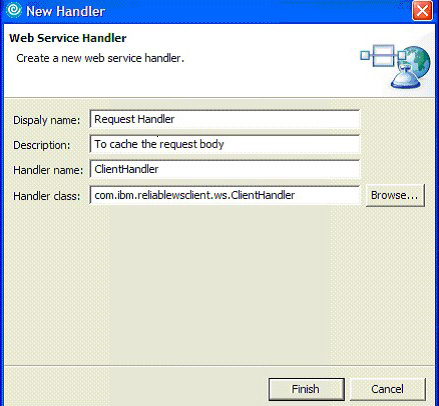了解如何通过使用 SOAP 消息处理程序来读取和缓存 SOAP 主体,从而为 SOAP/HTTP Web 服务编写可靠的客户机。这种方法在出现服务器故障或网络服务故障等情况下保存准备
Web 服务调用所使用的数据。客户机从 Web 服务获得响应后,可以将此数据从缓存丢弃,否则将使用相同的数据再次调用 Web 服务。
在通常的 Web 服务调用场景中,Web 服务客户机准备调用,并随后调用 Web 服务。如果出现临时系统错误、网络故障或服务不可用,准备调用过程中使用的数据将丢失。可以采用多种方式来保存此数据。一种方法是使用
SOAP 消息处理程序(以下简称处理程序);不过处理程序最常用于进行 SOAP Header 处理。SOAP Header
用于承载请求的上下文数据,例如安全性和事务性之类的服务质量(Quality of Service,QoS)请求。在这些情况下,可以使用处理程序来读取
SOAP 主体。本文将说明如何使用处理程序来缓存主体、如何在出现故障时使用此缓存以及如何编写可靠的 Web 服务客户机。
开发消息处理程序的主要目的是保存准备调用 Web 服务时使用的数据。清单 1 显示了一个消息处理程序,用于在发送请求时读取请求主体。
清单 1. 消息处理程序代码
package com.ibm.reliablewsclient.ws;
import java.util.logging.Logger;
import javax.xml.namespace.QName;
import javax.xml.rpc.JAXRPCException;
import javax.xml.rpc.handler.GenericHandler;
import javax.xml.rpc.handler.HandlerInfo;
import javax.xml.rpc.handler.MessageContext;
import javax.xml.rpc.handler.soap.SOAPMessageContext;
import javax.xml.soap.SOAPBody;
import javax.xml.soap.SOAPEnvelope;
import javax.xml.soap.SOAPMessage;
/*
* Created on Aug 3, 2006 @author Shailesh K Mishra (shailekm@in.ibm.com)
*
*/
public class ClientHandler extends GenericHandler {
private Logger logger;
public static SOAPBody body_of_request=null;
/**
*
*/
public ClientHandler() {
super();
// TODO Auto-generated constructor stub
}
/*
* (non-Javadoc)
*
* @see javax.xml.rpc.handler.Handler#init(javax.xml.rpc.handler.HandlerInfo)
*/
public void init(HandlerInfo arg0) {
// set up logger
logger = Logger.getLogger("com.ibm.reliablewsclient.ws");
super.init(arg0);
}
/*
* (non-Javadoc)
*
* @see javax.xml.rpc.handler.Handler#getHeaders()
*/
public QName[] getHeaders() {
// TODO Auto-generated method stub
return null;
}
/*
* (non-Javadoc)
*
* @see javax.xml.rpc.handler.Handler#handleRequest(javax.xml.rpc.handler.MessageContext)
*/
public boolean handleRequest(MessageContext arg0) {
try {
logger.info("Begin procession ClientHandler.handleRequest");
//generate SOAP body
SOAPMessage message = ((SOAPMessageContext) arg0).getMessage();
SOAPEnvelope envelope = message.getSOAPPart().getEnvelope();
SOAPBody body = envelope.getBody();
body_of_request=body;
logger.info("Request Body : " + body.toString());
logger.info("Completed procesing for ClientHandler.handleRequest");
} catch (Throwable ex) {
throw new JAXRPCException("Error in handleRequest", ex);
}
return true;
}
/*
* (non-Javadoc)
*
* @see javax.xml.rpc.handler.Handler#handleResponse(javax.xml.rpc.handler.MessageContext)
*/
public boolean handleResponse(MessageContext arg0) {
return true;
}
}
|
清单 1 中的处理程序代码将读取消息主体,并将其赋值给静态变量。此静态 body_of_request
字段用于缓存在准备 Web 服务调用时使用的数据。这是非常简单的缓存技术,但不能扩展。
托管客户机 是在托管环境中运行的客户机,即它通过应用服务器进行工作。我将说明如何通过使用 Servlet 作为客户机来编写可靠的托管客户机。首先,您需要编写
Web 服务,并随后为该 Web 服务生成存根。要生成存根,请在开发环境(我使用的是 IBM Rational ® Application
Developer™)中右键单击 Web 服务的 WSDL 文件,然后单击生成客户机选项。生成存根后,就可以编写 Servlet
了。清单 2 显示了 Servlet 的 doGet 方法。
清单 2. Servlet 的 doGet 方法
try {
DemoWSProxy proxy=new DemoWSProxy();
String str=proxy.generateId("John",2834742,"IBM Bangalore");
throw new RemoteException("To demostrate");
} catch (RemoteException e) {
try {
SOAPConnectionFactory fact;
fact = SOAPConnectionFactory.newInstance();
SOAPConnection con = fact.createConnection();
javax.xml.soap.SOAPFactory sf = SOAPFactory.newInstance();
MessageFactory mfact = MessageFactory.newInstance();
SOAPMessage smsg = mfact.createMessage();
SOAPPart prt = smsg.getSOAPPart();
SOAPEnvelope env = prt.getEnvelope();
env.addChildElement(ClientHandler.body_of_request);
//Set the WebService end point URL
URL endpoint = new URL("http://localhost:9080/
ReliableWSClientProject/services/DemoWS");
//Send the message
SOAPMessage response = con.call(smsg, endpoint);
System.out.println(response.getSOAPBody().toString());
response.writeTo(arg1.getOutputStream());
System.out.println();
//Close the connection
con.close();
} catch (UnsupportedOperationException e1) {
// TODO Auto-generated catch block
e1.printStackTrace();
} catch (MalformedURLException e1) {
// TODO Auto-generated catch block
e1.printStackTrace();
} catch (SOAPException e1) {
// TODO Auto-generated catch block
e1.printStackTrace();
}
}
|
调用 doGet 方法时,它将实例化 WSProxy 类(在存根生成期间创建),并调用
Web 服务的 generateId 方法。出于演示目的,我引发了一个 RemoteException
异常来表明使用的是缓存数据。调用 Web 服务时,消息处理程序将读取请求的主体,并将整个主体保存在 body_of_request
静态变量中。现在,当执行到 throw RemoteException 处时,将引发远程异常,流将进入
catch 块。在此 catch 块中,将使用所保存的请求主体来准备 SOAP
请求,以便再次调用 Web 服务。
要在 Servlet 调用 Web 服务时调用此处理程序,需要执行以下步骤来配置处理程序:
- 打开 web.xml 文件,并转到 Handlers 选项卡,如图 1 中所示。
图 1. Handlers 选项卡

- 单击 Add 并使用所需的值填写空白字段,如图 2 中所示。
图 2. 填写消息处理程序详细信息

- 单击 Finish 并保存 web.xml 文件。
这样就完成了消息处理程序的配置。
非托管 客户机是在非托管环境中运行的客户机,例如独立 Java™ 客户机。对于此类客户机,您需要以编程方式配置处理程序。清单
3 显示了可靠的非托管客户机代码。
清单 3. 非托管客户机
public class MyWSInvoker {
/**
*
*/
public MyWSInvoker() {
super();
// TODO Auto-generated constructor stub
}
public static void main(String[] args) {
try {
ArrayList handlerList = new ArrayList();
//Instantiate HandlerInfo class by passing your MessageHandler
// class and put this
//HandlerInfo class into an arraylist
handlerList.add(new HandlerInfo(ClientHandler.class, null, null));
ServiceFactory fact = ServiceFactory.newInstance();
Service service = fact.createService(new QName(
"http://ws.reliablewsclient.ibm.com", "DemoWSService"));
HandlerRegistry handlerRegistry = service.getHandlerRegistry();
//QName passed in setHandlerChain method should be QName of
// PortType
handlerRegistry.setHandlerChain(new QName(
"http://ws.reliablewsclient.ibm.com", "DemoWS"),
handlerList);
Call call = service.createCall();
call.setPortTypeName(new QName(
"http://ws.reliablewsclient.ibm.com", "DemoWS"));
call.setOperationName(new QName(
"http://ws.reliablewsclient.ibm.com", "generateId"));
call.setTargetEndpointAddress("http://localhost:9080/
ReliableWSClientProject/services/DemoWS");
call.setReturnType(new QName("http://www.w3.org/2001/XMLSchema","string"));
Object obj = call.invoke(new Object[] { "Jerry",new Integer(1234), "BIM" });
if (obj instanceof String) {
System.out.println((String) obj);
}
throw new RemoteException("my remote");
} catch (RemoteException e) {
// TODO Auto-generated catch block
//e.printStackTrace();
try {
Thread.sleep(10000);
SOAPConnectionFactory fact;
fact = SOAPConnectionFactory.newInstance();
SOAPConnection con = fact.createConnection();
javax.xml.soap.SOAPFactory sf = SOAPFactory.newInstance();
MessageFactory mfact = MessageFactory.newInstance();
SOAPMessage smsg = mfact.createMessage();
SOAPPart prt = smsg.getSOAPPart();
SOAPEnvelope env = prt.getEnvelope();
env.addChildElement(ClientHandler.body_of_request);
//Set the WebService end point URL
URL endpoint = new URL(
"http://localhost:9080/ReliableWSClientProject/services/DemoWS");
//Send the message
SOAPMessage response = con.call(smsg, endpoint);
System.out.println(response.getSOAPBody().toString());
response.writeTo(System.out);
System.out.println();
//Close the connection
con.close();
} catch (InterruptedException e1) {
//TODO Auto-generated catch block
e1.printStackTrace();
} catch (UnsupportedOperationException e1) {
// TODO Auto-generated catch block
e1.printStackTrace();
} catch (MalformedURLException e1) {
// TODO Auto-generated catch block
e1.printStackTrace();
} catch (SOAPException e1) {
// TODO Auto-generated catch block
e1.printStackTrace();
} catch (IOException e1) {
// TODO Auto-generated catch block
e1.printStackTrace();
}
} catch (ServiceException e) {
// TODO Auto-generated catch block
e.printStackTrace();
}
}
}
|
要在这种情况下配置消息处理程序,请通过按以下方式传入消息处理程序类名称来实例化 HandlerInfo:
new HandlerInfo(ClientHandler.class, null, null);
|
然后将此 HandlerInfo 类添加到数组列表中:
ArrayList handlerList = new ArrayList();
handlerList.add(new HandlerInfo(ClientHandler.class, null, null));
|
现在获取 HandlerRegistry:
HandlerRegistry handlerRegistry = service.getHandlerRegistry();
|
在 HandlerRegistry 注册处理程序
handlerRegistry.setHandlerChain(
new QName("http://ws.reliablewsclient.ibm.com", "DemoWS"),handlerList);
|
这样就完成了消息处理程序的配置。 当将请求发送到 Web 服务时,此处理程序将读取 SOAP 主体,并将其分配给 body_of_request
静态字段。
清单 3 引发了一个 RemoteExpection,以说明使用了缓存的主体信息。当执行到
catch 块时,将使用缓存的主体准备 SOAP 请求,并随后调用 Web 服务。
在本文中,您了解了使用消息处理程序编写可靠的托管和非托管 Web 服务客户机的简单步骤。使用静态字段缓存请求主体的方法并不完善,还是一项有待发展的技术,但是您可以利用一些好的机制来进行缓存。
| 描述 |
名字 |
大小 |
下载方法 |
| Source code for samples |
Sample.zip |
33KB |
HTTP |
| Runtime description |
runtime.txt |
1KB |
HTTP |
学习
讨论
|

